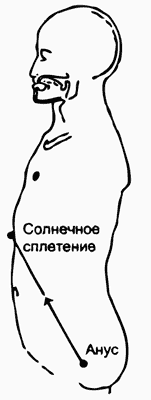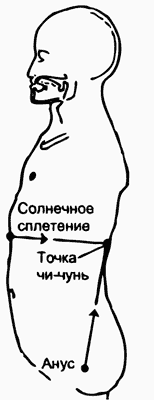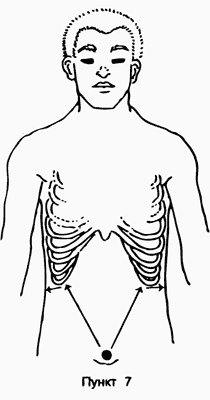“Quadruple Breathing” is one of the powerful exercises designed to increase the density of qi in the body, which is achieved by combining breathing and “perineal strength”.
Most of the last lesson was devoted to reviewing the material covered and summarizing information related to the practice of quadruple breathing. This week we will pay special attention to the solar plexus and torso. After the “power of the perineum” flows from the solar plexus to the chi-chun point (T-11), the “energy breathing” is concentrated in the left and right hypochondrium.

1. Take a slow breath like “abdominal breathing.”
2. Inhale a little air and mentally direct the “perineal force” into the solar plexus.
3. Without exhaling, pull the solar plexus towards the spine.

4. Inhale a little air and, with an effort of will, direct the “power of the perineum” to the chi-chun point located on the back, at the level of the solar plexus.
5. Inhale a little air and pull the left anal muscles towards the left hypochondrium. Feel the left side of your chest expanding to the left.
6. Inhale a little air and pull the right anal muscles towards the right hypochondrium.
Feel the right side expanding
chest to the right side.
7. Inhale a little air and at the same time pull the right and left muscles of the anus towards the right and left sides of the hypochondrium. Feel both sides of your chest expanding.
8. Exhale slowly and hold your breath.
9. Relax, take a breath and repeat the exercise at least three times.

The considered exercise can be combined with the already mastered exercises of parts 1 and 2 of quadruple breathing. Start with the navel and belt, then move to the “sperm palace” area (ovaries), then to the hips, solar plexus and, finally, the hypochondrium. It is important that when you inhale, you feel the expansion of the corresponding area. With practice, you will learn to perform the exercise “in one breath,” that is, without stopping to exhale. In this case, any tension should be avoided.
During the exercise, you will feel how, as the qi flows in, some parts of the spine “open.” In addition, the exercise is extremely beneficial for the diaphragm.



